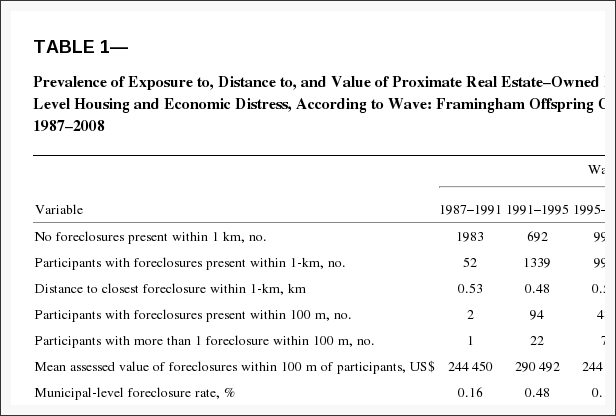
Effects of Proximate Foreclosed Properties on Individuals’ Weight Gain in Massachusetts, 1987-2008
Abstract
Objectives. We assessed the extent to which living near foreclosed properties is associated with individuals’ subsequent weight gain.
Methods. We linked health and address information on 2068 Framingham Offspring Cohort members (7830 assessments) across 5 waves (1987–2008) to records of all Massachusetts foreclosures during that period. We used counts of lender-owned foreclosed properties within 100 meters of participants’ homes to predict body mass index (BMI; defined as weight in kilograms divided by the square of height in meters) and the odds of being overweight (BMI ≥ 25), adjusted for individual and area-level covariates.
Results. Mean BMI increased from 26.6 in 1987–1991 to 28.5 in 2005–2008; overweight prevalence increased from 59.0% to 71.3%. Foreclosures were within 100 meters of 159 (7.8%) participants’ homes on 187 occasions (1.8%), in 42 municipalities (21%). For each additional foreclosure, BMI increased by 0.20 units (95% confidence interval [CI] = 0.03, 0.36), and the odds ratio for being overweight associated with proximity to a foreclosure was 1.77 (95% CI = 1.02, 3.05).
Conclusions. We found a robust association between living near foreclosures and BMI, suggesting that neighbors’ foreclosures may spur weight gain.
Citation:
M. Arcaya, M.M. Glymour, P. Chakrabarti, N.A. Christakis, I. Kawachi, and S.V. Subramanian, "Effects of Proximate Foreclosed Properties on Individuals’ Weight Gain in Massachusetts, 1987-2008" American Journal of Public Health, 103 (9):e50-6 (September, 2013); http://dx.doi.org/10.2105/AJPH.2013.301460